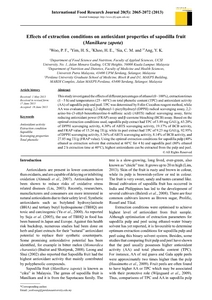Citation
Woo, F. P. and Yim, Hip Seng and Khoo, Hock Eng and Sia, Chiaw Mei and Ang, Yee Kwang
(2013)
Effects of extraction conditions on antioxidant properties of sapodilla fruit (Manilkara zapota).
International Food Research Journal, 20 (5).
pp. 2065-2072.
ISSN 1985-4668; ESSN: 2231-7546
Abstract
This study investigated the effects of different percentages of ethanol (0 - 100%), extraction times (1 - 5 h) and temperatures (25 - 60°C) on total phenolic content (TPC) and antioxidant activity (AA) of sapodilla pulp and peel. TPC was determined by Folin-Ciocalteu reagent method, while AA was evaluated using 2,2-diphenyl-1-picrylhydrazyl (DPPH) radical scavenging assay, 2,2-azino-bis-(3-ethyl-benzothiazoline-6-sulfonic acid) (ABTS) radical scavenging assay, ferric reducing antioxidant power (FRAP) assay and ß-carotene bleaching (BCB) assay. Based on the optimal extraction conditions used, sapodilla pulp extract had TPC of 3.89 mg GAE/g, 63.20% of DPPH scavenging activity, 4.30% of ABTS scavenging activity, 19.17% of BCB activity, and FRAP value of 15.24 mg TE/g; while its peel extract had TPC of 9.23 mg GAE/g, 92.95% of DPPH scavenging activity, 5.36% of ABTS scavenging activity, 8.14% of BCB activity, and 27.85 mg TE/g (FRAP value). Using the optimal extraction conditions for sapodilla pulp (40% ethanol as extraction solvent that extracted at 60°C for 4 h) and sapodilla peel (80% ethanol and 2 h extraction time at 40°C), highest antioxidants can be extracted from the pulp and peel.
Download File
![[img]](http://psasir.upm.edu.my/41071/1.hassmallThumbnailVersion/Effects%20of%20extraction%20conditions%20on%20antioxidant%20properties%20of%20sapodilla%20fruit%20%28Manilkara%20zapota%29.pdf)  Preview |
|
PDF
Effects of extraction conditions on antioxidant properties of sapodilla fruit (Manilkara zapota).pdf
Download (590kB)
| Preview
|
|
Additional Metadata
Actions (login required)
 |
View Item |

